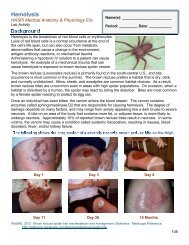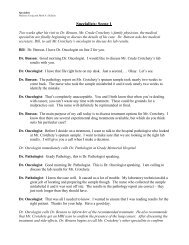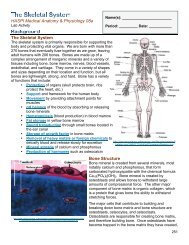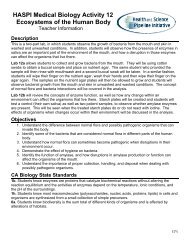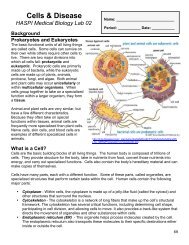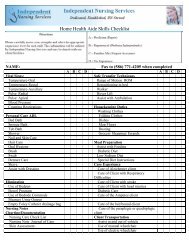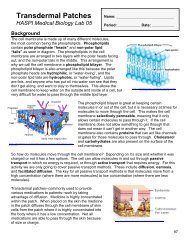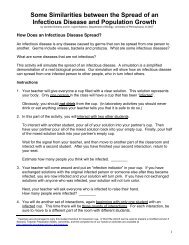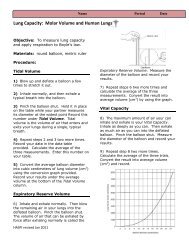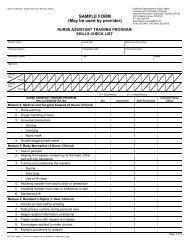You also want an ePaper? Increase the reach of your titles
YUMPU automatically turns print PDFs into web optimized ePapers that Google loves.
Name: __________________________________________ Date: ___________ Period: _________<br />
Materials<br />
Spot plate 2% Albumin (protein) 1% Hydrochloric acid<br />
20 pH strips 3% Pepsin Biuret<br />
10 stirring sticks 1% Starch solution 2% Amylase<br />
Forceps Potassium iodine Corn oil<br />
Paper towels Water Liquid soap<br />
Procedure<br />
Purpose: The goal of this lab will be to observe how digestive enzymes are able to break down<br />
macromolecules. All data tables are located in the analysis portion of the lab.<br />
PART A: Protein <strong>Digestion</strong><br />
In part A the albumin represents a polypeptide protein. Pepsin is the enzyme needed to break down<br />
the albumin into amino acids, but can only work within a certain pH range. The Biuret will turn pink<br />
with smaller protein chains and will turn purple in the presence of large proteins.<br />
1. Using a pencil, label the wells on your spot plate 1-5.<br />
2. Place 5 drops of 2% Albumin in wells 1-4.<br />
3. Add 5 drops of 1% HCl to wellS 2, 4, and 5.<br />
4. Add 5 drops of 3% Pepsin to wells 3 and 4.<br />
5. Use separate stirring sticks to mix each well, and allow them to sit for 5-7 minutes.<br />
6. Use the forceps to dip a separate pH strip into each of the wells 1-5. Compare the color<br />
change of each strip to the pH strip chart to determine the pH of the mixture in each well.<br />
Record your results in Data Table 1.<br />
7. Add 2 drops of Biuret to wells 1-5. A positive test for protein breakdown will turn pink. If the<br />
well is positive, put a + in Data Table 1. If the well is negative put a -.<br />
8. Record your observations of each of the mixtures in Data Table 1.<br />
9. Rinse out your spot plate and dry it off with a paper towel.<br />
PART B: Carbohydrate <strong>Digestion</strong><br />
In part B starch is a polysaccharide, and amylase is the enzyme responsible for breaking starch down<br />
into monosaccharides. Since the potassium iodine tests for starch, you will be looking for a negative<br />
test to determine whether amylase actually broke down the starch.<br />
1. Using a pencil, label wells 1 and 2 on the spot plate.<br />
2. Add 15 drops of 1% Starch solution to wells 1 and 2.<br />
3. Add 5 drops of 2% Amylase solution to well 2.<br />
4. Use separate stirring sticks to mix each well, and allow them to sit for 5-7 minutes.<br />
5. Add 1 drop of Potassium iodine to wells 1 and 2. A positive test for starch will turn dark blueblack.<br />
If a well is positive for starch, put a + in the Data Table 2. If the test is negative for<br />
starch put a –.<br />
6. Record your observations of each of the mixtures in Data Table 2.<br />
7. Rinse out your spot plate and dry it off with a paper towel.<br />
Adapted from Neo/Sci Food <strong>Digestion</strong> Lab Activity 2011 237



